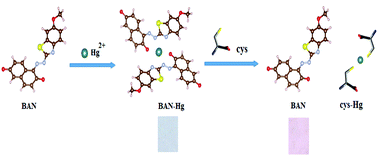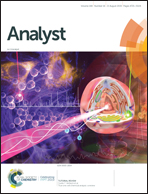Dual chemosensor for the rapid detection of mercury(ii) pollution and biothiols†
Abstract
A new benzothiazole azo dye [(E)-1-((6-methoxybenzo[d]thiazole-2-yl)diazenyl)naphthalene-2,6-diol] (also known as “BAN”), has been synthesised and used as a chemosensor for the rapid and selective detection of mercury(II) ions in water. The pink coloured chemosensor turns blue when reacted with mercury(II) ions due to the formation of a 2 : 1 coordination complex. The complex formation causes a bathochromic shift of the chemosensor's UV absorption peak from 540 to 585 nm and turns on a highly selective fluorescence emission at 425 nm. The change in the optical property of BAN upon complexation with mercury(II) was confirmed by ab initio calculations. The new chemosensor was used to quantify mercury(II) ions in water by fluorescence spectroscopy down to 5 × 10−8 M (10 ppb). The limit of detection (LOD) of Hg2+ was 9.45 nM (1.8 ppb) which satisfies the maximum allowable Hg2+ concentration in drinking water that is set by the WHO. The BAN–Hg(II) complex was used for the determination of cysteine (Cys) in aqueous solution by UV-Vis spectroscopy down to 1 × 10−7 M. The thiol-containing amino acid preferentially coordinates the mercury ions of the BAN–Hg(II) complex. This causes dissociation of the blue-coloured complex and the liberation of the pink-coloured BAN dye. The colour change of the BAN–Hg(II) complex from blue to pink was selective to the Cys biothiol while other non-thiol containing amino acids did not cause a colour change. For the in-field application, filter paper strips were loaded with the BAN–Hg(II) complex and used as a disposable sensor for the detection of cysteine (Cys) by the naked eye. Therefore, the BAN chemosensor offers a sensitive, and rapid tool for the detection of mercury(II) in water. In addition, the BAN–Hg(II) complex can be used as a simple and selective chemosensor of the screening of purified biothiols, such cysetine, homocysteine and glutathione in biology research and pharmaceutical/food industries.



 Please wait while we load your content...
Please wait while we load your content...